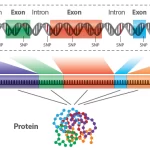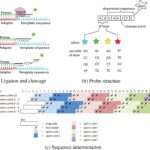
Understanding Biological Sequences: DNA, RNA, and Protein Basics
October 31, 2023I. DNA – Deoxyribonucleic Acid
Fundamentals of DNA
DNA is the hereditary material in all known living organisms and some viruses. It carries the genetic instructions used in the growth, development, functioning, and reproduction of all known living organisms and many viruses.
Structure and Components
DNA is composed of molecules called nucleotides, each consisting of a phosphate group, a sugar group, and a nitrogen base. There are four types of nitrogen bases in DNA: adenine (A), thymine (T), cytosine (C), and guanine (G).
Double Helix and Base Pairing
The structure of DNA is a double helix, which resembles a twisted ladder. The sides of the ladder are formed by the sugar and phosphate groups of the nucleotides, while the rungs consist of the base pairs. Adenine (A) pairs with thymine (T), and cytosine (C) pairs with guanine (G).
Replication and Genetic Code
DNA is capable of self-replication, which is essential for cellular division and reproduction. The sequence of the bases constitutes the genetic code, which provides instructions for the synthesis of proteins through the processes of transcription and translation. These proteins carry out most of the work in cells, constituting enzymes, hormones, and antibodies, among others.
II. RNA – Ribonucleic Acid
Role in Protein Synthesis
RNA, or ribonucleic acid, is a single-stranded molecule that plays a crucial role in translating the genetic code from DNA into functional proteins. It acts as the intermediary between the genetic information encoded in DNA and the amino acid sequence of proteins.
Types of RNA
There are several types of RNA, each with a distinct function in the process of protein synthesis:
Messenger RNA (mRNA)
mRNA is responsible for transferring the genetic code from DNA in the nucleus to the ribosomes, the sites of protein synthesis in the cell.
Transfer RNA (tRNA)
tRNA brings amino acids to the ribosome, where they are added to the growing polypeptide chain during protein synthesis.
Ribosomal RNA (rRNA)
rRNA is an integral component of the ribosome’s structure and function, helping to catalyze the formation of peptide bonds between amino acids.
Base Composition
Unlike DNA, RNA’s base composition includes adenine (A), uracil (U) instead of thymine, cytosine (C), and guanine (G). The presence of uracil is one of the key differences between RNA and DNA.
III. Proteins
Amino Acid Chains
Proteins are complex molecules made up of one or more long chains of amino acids. These chains fold into specific three-dimensional structures that determine the protein’s properties.
Genetic Encoding
The sequence of amino acids in a protein is encoded by the sequence of nucleotide triplets, known as codons, in messenger RNA (mRNA). During the process of translation, each triplet codon specifies a particular amino acid.
Structure and Function
The specific sequence and number of amino acids in a protein chain cause the chain to fold into a three-dimensional structure. This structure is critical because it determines the protein’s function. Changes in the sequence can lead to alterations in the structure and function, which can have significant biological consequences.
Functional Diversity
Proteins have a vast array of functions within organisms. They can act as enzymes, catalyzing metabolic reactions to support life. Proteins are also involved in DNA replication, cellular signaling, immune responses, and the transport of molecules across cellular membranes. This functional diversity is essential for the complex processes of life.
IV. Central Dogma of Molecular Biology
Genetic Information Flow
The Central Dogma of Molecular Biology describes the flow of genetic information within a biological system. It outlines the process by which genetic information is transferred from the hereditary material, DNA, to RNA, and then to the synthesis of proteins.
Framework for Biological Function
This dogma provides a fundamental framework for understanding the transfer of genetic information and how it dictates the biological function of organisms. It is a key concept in molecular biology that explains the expression of genes into traits and the continuity of life.
V. Analyzing Sequences
Sequencing Techniques
Advancements in methods such as DNA sequencing have made it possible to determine the precise order of nucleotides in a DNA molecule. These techniques are fundamental in genomics to understand genetic variation and function.
Bioinformatics
Bioinformatics combines computational tools and biological data to analyze and interpret biological sequences. This field is essential for managing and analyzing the vast amount of data produced by sequencing technologies.
Evolution and Function
Comparative sequence analysis across different organisms can reveal evolutionary relationships, indicating how species have diverged from common ancestors. It also helps identify functional regions within genes and proteins, providing insight into their roles in the organism’s biology.


















